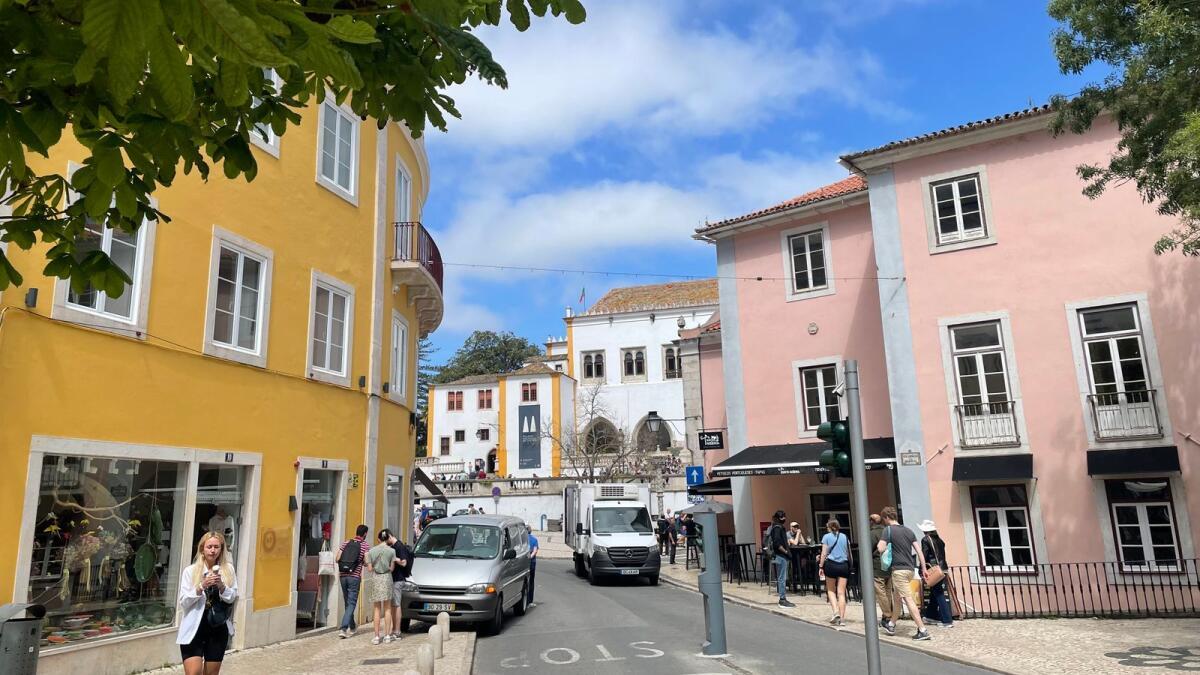How To Make The Most Of Your Time In Sintra, Portugal

(MENAFN- Khaleej Times)
Published: Thu 15 Aug 2024, 7:35 PM
One warm morning, a packed train from Lisbon, Portugal brings me to Sintra, a charming little city located in the hills of Serra de Sintra and home to palaces, fairytale castles, castle ruins, water fountains and villas that belonged to royalty and aristocracy. From the number of tourists standing in the train, it is obvious that Sintra is popular – a fact reconfirmed when it took me ten minutes to exit the station and miss the circular bus as a result.
Fortunately, I had a timed entry ticket into Pena Palace, Sintra’s star attraction, for 10:15 am, which gave me enough time to make a few stops before arriving at my destination. For this reason alone, I was glad for my taxi driver, Alfonso, an immigrant from Argentina, who, besides being a keen conversationalist also knew the spots with the best views.
It is he who told me of the celebrities living in Sintra and the significance of water fountains dotting the city.
The water fountains of Sintra
We arrived at an ancient but popular water fountain – the Sabuga Water Fountain – with its back wall capped by an ornately designed gable with a yellow sun. The water here was clearly magical, considering the number of people filling up bottles and cans. Alfonso cleared the air for me -“It is best for curing gastrointestinal issues,” he said, while heading to the fountain to fill up his bottle. I followed suit. In existence since the Middle Ages, Sabuga finds a mention in literature dating back to the 14th century. What we see today dates to the 18th century, having replaced the earlier one destroyed in the 1755 earthquake.
I filled my water bottle too, as a contingency, given all the paella I wanted to eat later in the day.
Legend states anyone who drinks Sabuga’s water will remember Sintra forever. I am not sure if I’d use that word today, but to be fair, I am not likely to forget Sintra in a hurry.
We drove uphill for a stop at the Biester Palace (opened recently to the public after restoration). It is said to have a historical hall with a grand library, which I was sad to miss because it was closed when we drove up to its gate. The security guard was kind enough to allow me a quick tour of its gardens.
It was soon time for Pena Palace.
Pena Palace
Alfonso bid goodbye at the entrance. Pena Palace with its brightly coloured red and yellow walls, stairways, turrets and balconies, looked like a living and breathing fairy tale castle. The exterior of the Palace had stunning stone carvings, and the entrance was guarded by the statue of [the Greek deity] Triton. The interior was spectacular with several staterooms with grand furniture. It was classified as a Unesco World Heritage Site in 1995. Of all the palaces and castles in Sintra, it is the most famous one – and rightly so. It is not hard to see why Pena Palace inspired King Ludwig IIs German castle, Neuschwanstein, which in turn inspired Walt Disney’s castle at Disneyland.
Initially built as a monastery in the 12th century, it became a royal palace in the mid 19th century and remained so until Portugal became a republic in 1905. It was renovated by successive monarchs who added their own styles. Pena Palace is the pinnacle of romanticism in Portugal and the legacy of Ferdinand II. The architecture is influenced by medieval Catholic, Islamic, and Greek mythology.
Two hours later I emerged from this surreal Palace, having experienced every kind of emotion and yet feeling as though I have missed much. Lush forests surrounded the palace but there wasn’t enough time to explore it.
Soon after, there was a bus waiting to make the return trip. I hopped on, having lost the enthusiasm to hike downhill. As the bus wound down the forested roads towards the city centre, it was easy to see why it was not only Walt Disney who succumbed to the charm of Sintra. This charming city was also a favourite spot for British Secret Agents (Bond was seen driving his Aston Martin in the film On Her Majesty’s Secret Service).
The city centre was bustling with tourists, but I found a spot at the Romaria de Baco (as Alfonso had recommended) and immensely enjoyed the traditional Portuguese lunch, followed up with custard tarts at Queijadas da Sapa, the first bakery to make Sintra’s famous cheese and cinnamon tarts in a thin crust. It has been in operation since 1756. These small and spicy bites are the pride and joy of Sintra.
Somewhere, live music plays. That is the thing about Sintra – the architecture is unique, the winding alleyways and cobblestone streets enticing, and the vibe uplifting. Even if one took away all these wonderful castles and palaces, Sintra is still worth the trip from Lisbon just for the tarts. I was especially happy to see a functioning telephone booth facing the National Palace grounds – and to fulfil my desire to call from a telephone booth, I lifted the receiver and got the shock of my life – it had a dial tone.
The National Palace
After lunch, it was time to visit the National Palace, the pride of Sintra. It’s hard to miss this gigantic structure with its two huge conical chimneys. Though not as flashy as Pena Palace, the National Palace is also among the best preserved medieval royal palaces in the country.
Interestingly, nearly every king and queen of Portugal has spent some time in residence at the National Palace for varying lengths of time and these visits have left their mark and memories of their lives here. Looking closely, you will find that the palace was shaped by different styles and influences of each prevailing period.
Whether you spend a day or longer, Sintra is easily one of Portugal’s most stunning cities and despite its small size, it hides some architectural wonders.
My day ended with a brief visit to the Quinta de Regaleira, which had a huge Gothic house and extensive gardens. This was on the bus route 435 but a brisk twenty-minute walk past some spectacularly old blue and yellow buildings and tall trees brought me to it. The most attractive part of this visit was the Initiation Well representing ancient secret orders like the Knights Templar and the Masons. I wound down the spiral stairwell slowly (and slowly is the way to go to avoid feeling dizzy) right to the bottom before making my exit through a tunnel.
It was somewhat a fitting end to a packed day.
…
MENAFN15082024000049011007ID1108560343
Legal Disclaimer:
MENAFN provides the information “as is” without warranty of any kind. We do not accept any responsibility or liability for the accuracy, content, images, videos, licenses, completeness, legality, or reliability of the information contained in this article. If you have any complaints or copyright issues related to this article, kindly contact the provider above.
link






